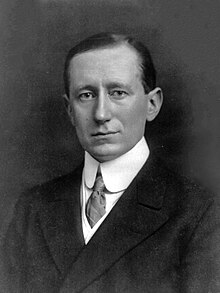This article needs additional citations for verification. (July 2022) |




It is generally recognized that the first radio transmission was made from a temporary station set up by Guglielmo Marconi in 1895 on the Isle of Wight. This followed on from pioneering work in the field by a number of people including Alessandro Volta, André-Marie Ampère, Georg Ohm, James Clerk Maxwell and Heinrich Rudolf Hertz.[2][full citation needed][3][full citation needed][4]
The radio broadcasting of music and talk intended to reach a dispersed audience started experimentally around 1905–1906, and commercially around 1920 to 1923. VHF (very high frequency) stations started 30 to 35 years later. In the early days, radio stations broadcast on the longwave, mediumwave and shortwave bands, and later on VHF (very high frequency) and UHF (ultra high frequency). However, in the United Kingdom, Hungary, France and some other places, from as early as 1890 there was already a system whereby news, music, live theatre, music hall, fiction readings, religious broadcasts, etc., were available in private homes [and other places] via the conventional telephone line, with subscribers being supplied with a number of special, personalised headsets. In Britain this system was known as Electrophone, and was available as early as 1895 or 1899 [sources vary] and up until 1926.[4] In Hungary, it was called Telefon Hírmondó [1893-1920s], and in France, Théâtrophone [1890-1932]).
By the 1950s, virtually every country had a broadcasting system, typically one owned and operated by the government. Alternative modes included commercial radio, as in the United States; or a dual system with both state sponsored and commercial stations, introduced in Australia as early as 1924, with Canada following in 1932. Today, most countries have evolved into a dual system, including the UK. By 1955, practically every family in North America and Western Europe, as well as Japan, had a radio. A dramatic change came in the 1960s with the introduction of small inexpensive portable transistor radios which greatly expanded ownership and usage. Access became practically universal around the world.
- ^ "The Music Trade Review". 63 (19). November 4, 1916.
{{cite journal}}: Cite journal requires|journal=(help) - ^ Colligan, Mimi (1991). Golden Days of Radio. Australia Post. ISBN 0642160252.
- ^ Australian Radio History. Bruce Carty. 2011. ISBN 9780646555812.
- ^ a b Bernard Harte (2002). When Radio was the Cat's Whiskers. Rosenberg Publishing, 2002. p. 138. ISBN 9781921719707. Archived from the original on 2022-06-16. Retrieved 2020-10-26.